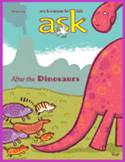|
|
ASK: Overview of the February 2014 Issue
By Kirsten W. Larson
|
|
|
|
|
|
|

ASK is an ad-free science magazine for children ages 7 to 10. There are nine issues each year, each one
focused on a theme, whether it's Mars, the Ice Age, or Vikings. The tone is upbeat, lively, and humorous. Cartoon
characters comment on articles, adding to the fun.
The February 2014 issue is "After the Dinosaurs" and focuses on the last Ice Age.
Overview
• Pages 2-3: "Scoops," a regular feature covering current scientific discoveries. This was written by Meg Moss,
contributing editor.
• Pages 4-5 "Nestor's Dock" by Jeffrey Ebbeler, a regular cartoon feature.
• Pages 6-10: "What Killed the Dinosaurs?" Discusses theories about what might have killed the dinosaurs, including
a meteorite impact and its aftermath. Readers learn that volcanic eruptions may have already weakened dinosaurs and
plants before the impact. The author details the clues scientists have pieced together that support the meteorite
theory.
• Page 11: "What Didn't Kill the Dinosaurs." A humorous look at discounted theories of what killed dinosaurs told
via cartoons.
• Page 12-13: "Tale of the Whale." Shows how whales trace their history to the time just after the dinosaurs.
• Page 14-19: "Old Cold: Living in Ice Age America." This article takes a peek at the Ice Age in North America. Kids
meet real, live giants, from woolly mammoths to giant sloths and sabertooth cats. They also meet early humans who
may have hunted mammoths and mastodons to extinction.
• Page 20-21: "Parking Lot Paleontology." A bulldozer in Los Angeles turned up a Columbian mammoth and 23 boxes worth of
Ice Age fossils while making a new parking garage. Paleontologists from the La Brea Tar Pits have spent the last
few years unearthing the fossils. Aisling Farrell of the Tar Pits is interviewed.
• Page 22-23: "Giant Killer Meteor Survival Tips." A humorous look at how some species survived the meteorite. For
example, some hid underground, others went dormant, etc. This is told in a comic strip format.
• Page 24-27: "Terror Birds!" Large, fast and just-plain-mean birds ruled the earth in the days after the dinosaurs,
munching mammals for lunch. Robert Chandler, who hunts for fossils of some of these beasts is interviewed, as is
Luis Chiappe of the Los Angeles Natural History Museum.
• Page 28-31: "Contests and Letters," a regular feature where letters and art from readers are featured.
• Page 32: "Ask Jimmy and The Bug." Cartoon characters Jimmy and the Bug answer reader questions.
• Page 33: "Bot's Number Tricks." A coin toss magic trick to try on your friends.
• Back cover: "Marvin and Friends," a regular cartoon feature.
Additional Information
Queries are submitted online via Submittable.
Articles normally run 800-1600 words including sidebars.
Check Submittable for upcoming themes and query due dates.
Writers should submit a cover letter that includes a short biographical statement, a one-page outline of the
article, a sample opening paragraph, and a bibliography. New writers should submit resume and two unedited writing
samples of 200 words or more on any nonfiction topic.
Liz Huyck is the editor.
Writing for Children's Magazines, May 2014
Cover Photo Credit: Courtesy of ePals Media
Text: Copyright Kirsten W. Larson
|
|
|
|
|
|
|
|
|

|
|
Kirsten W. Larson is freelance children's writer. Her work appears in Boys' Quest, ASK,
and ODYSSEY. Kirsten spent six years working for NASA and frequently writes about space for kids. She is at
work on two books for the educational market.
|
|
|
|
|
|
|
|
|